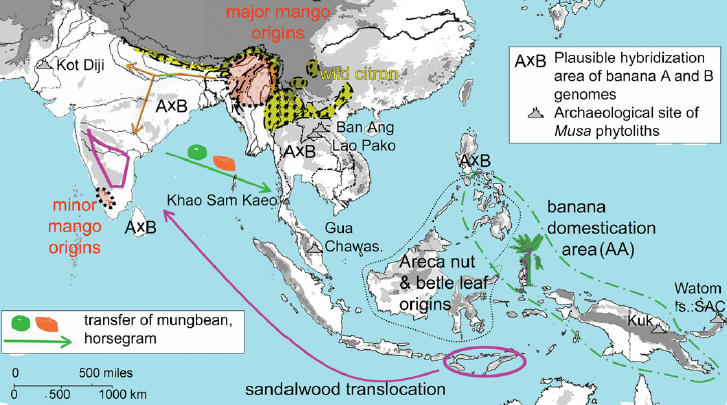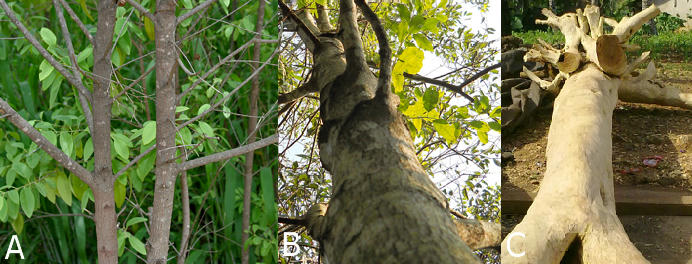 White sandal (Santalum album) is the iconic flora of the province of East Nusa Tenggara. The first government funded university in the province, Nusa Cendana University, bears the name of this tree plant in Bahasa Indonesia, cendana. It is an endemic plant of the province and other nearby islands, but for so long has been wrongly believed as native to the Indian sub-continent and hence named indian sandal. A recent study revealed that white sandal was transported to Indian sub-continent as an important part of major prehistoric translocations of economic plants from Southeast Asia. Another study established East Nusa Tenggara and other nearby islands as the center of origin of this plant.
White sandal (Santalum album) is the iconic flora of the province of East Nusa Tenggara. The first government funded university in the province, Nusa Cendana University, bears the name of this tree plant in Bahasa Indonesia, cendana. It is an endemic plant of the province and other nearby islands, but for so long has been wrongly believed as native to the Indian sub-continent and hence named indian sandal. A recent study revealed that white sandal was transported to Indian sub-continent as an important part of major prehistoric translocations of economic plants from Southeast Asia. Another study established East Nusa Tenggara and other nearby islands as the center of origin of this plant. | ||
| Map summarising major prehistoric translocations of economic plants between Southeast Asia and South Asia, asdiscussed in Fuller et al. (2011) |
White sandal is a hemiparasitic tree occuring from coastal dry forests up to 700 m elevation. It normally grows in sandy or stony red soils, but also presents in a wide range of soil types, in a temperature up to 38°C and annual rainfall ranging 500-3000 mm. The plant parasitises the roots of other plant species, with a haustorium adaptation on its own roots, but without major detriment to its hosts. An individual will form a non-obligate relationship with up to 300 plant species, including its own, from which it derives macronutrients such as phosphorus, nitrogen and potassium. The hosts also provide shade, especially during early phases of development. It may propagate itself through wood suckering during its early development, establishing small stands.
Description
Evergreen trees, to 10 m high, bark surface dark grey to nearly black, rough with short vertical cracks. Leaves simple, opposite, estipulate; petiole 12-18 mm long, slender, glabrous, grooved above; lamina 3.7-12 x 2-4 cm, elliptic, elliptic-ovate or ovate-lanceolate, base acute or round, apex acute, margin entire, glabrous, shiny above and glaucous beneath, coriaceous; lateral nerves 8-13 pairs, pinnate, faint, intercostae reticulate, obscure. Flowers bisexual, 5-6 mm across, reddish-purple, in axillary and terminal paniculate cymes, much shorter than leaves; tepals 5, basally connate into a campanulate tube of 2 mm long, shortly connate to the basal part of the ovary; lobes 2.5 x 1.5 mm, ovate, thin, fleshy, glaucescent without, minutely ciliate; disc concave, adhering to the bottom of perianth, its lobes alternates with tepals; stamens 5, alternates with disc; filaments 1 mm; anthers 0.7 mm, ovoid, 2-celled; ovary superior later half inferior at the time of flowering, globose, 1 mm, 1-celled, ovules 2-3, pendulous from below the long, acuminate, central column; style 1.5 mm, stigma 3 lobed. Fruit a drupe, 8-12 mm across, globose, blackish-purple, annulate above, beaked with the basal part of the style; seed one. See also description by World Agroforestry Centre.
 |
| White sandal mature tree, A: growth habit, B: canopy, and C: trunk |
 |
| Trunk. A: trunk of a young tree, B: trunk of a mature tree, and C: wood after the bark has been removed |
 |
| Leaves, flowers, and fruits, A: Leaves, B: composite flowers, and C: mature and immature fruits |
 |
| Propagation, A: germinating seeds, B: seedlings, and C: an established seedling after transplanting |
References
Fuller, D.Q., Boivin,N., Hoogervorst, T. & Allaby, R. (2011). Across the Indian Ocean: the prehistoric movement of plants and animals. Antiquity 85: 544–558
Harbaugh, D.T., & Baldwin, B.G. (2007). Phylogeny and biogeography of the sandalwoods (Santalum, Santalaceae): repeated dispersals throughout the Pacific. Am. J. Bot. 94 (6): 1028-1040
IUCN (2014). The IUCN Red List of Threatened Species: Santalum album.
Hey Nice Blog!!! Thank you for sharing information. Wonderful blog & good post more relative white sandal wood
BalasHapus